Straits of Mackinac
The Straits of Mackinac (/ˈmækɪnɔː/ MAK-in-aw) are narrow waterways in the U.S. state of Michigan between Michigan's Lower and Upper Peninsulas. The main strait flows under the Mackinac Bridge and connects two of the Great Lakes, Lake Michigan and Lake Huron. The main strait is 3 1⁄2 miles (5.6 kilometers) wide and has a maximum depth of 295 feet (90 meters; 49 fathoms).[2] Hydrologically, the two connected lakes can be considered one lake, which is called Lake Michigan–Huron. Historically, the native Odawa people called the region around the Straits Michilimackinac. The Straits of Mackinac are "whipsawed by currents unlike anywhere else in the Great Lakes".[3]
| Straits of Mackinac | |
|---|---|
| |
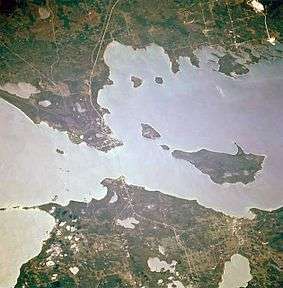 Overhead view of the Straits of Mackinac linking Lakes Michigan (left) and Huron (right) | |
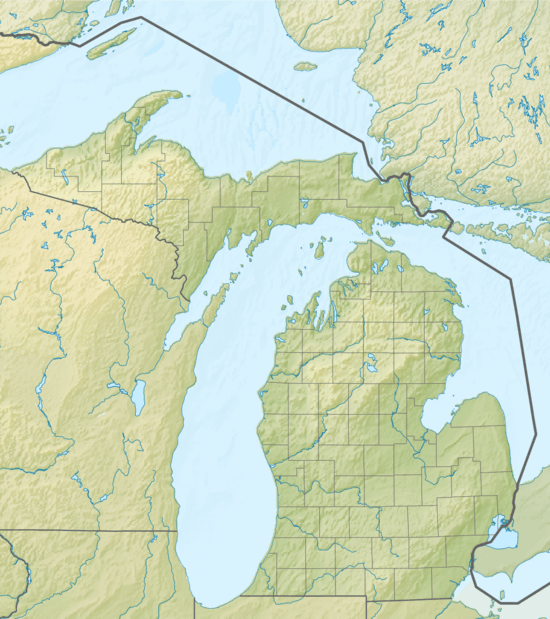 Straits of Mackinac  Straits of Mackinac  Straits of Mackinac | |
| Location | Lake Michigan-Lake Huron |
| Coordinates | 45°48′50″N 84°45′00″W |
| Type | Strait |
| Etymology | Michilimackinac |
| Primary inflows | Lake Michigan |
| Primary outflows | Lake Huron |
| Basin countries | United States |
| Max. depth | 295 ft (90 m) |
| References | [1] |
Islands forming the edge of Straits of Mackinac include the two populated islands, Bois Blanc and Mackinac, and one that is uninhabited: Round island.[1] The Straits of Mackinac are major shipping lanes, providing passage for raw materials and finished goods and connecting, for instance, the iron mines of Minnesota to the steel mills of Gary, Indiana. Before the railroads reached Chicago from the east, most immigrants arrived in the Midwest and Great Plains by ships on the Great Lakes. The straits are five miles (8 km) wide at their narrowest point, where they are spanned by the Mackinac Bridge. Before the bridge was built, car ferries transported vehicles across the straits. Today passenger-only ferries carry people to Mackinac Island, which does not permit cars. Visitors can take their vehicles on a car ferry to Bois Blanc Island.
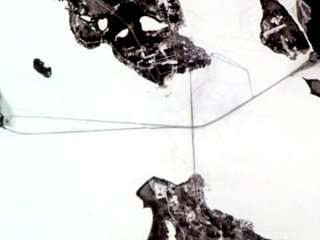
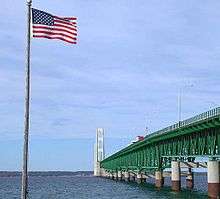
The straits are shallow and narrow enough to freeze over in the winter. Navigation is ensured for year-round shipping to the Lower Great Lakes by the use of icebreakers.
The straits were an important Native American and fur trade route. The Straits of Mackinac are named after Mackinac Island. The local Ojibwe Native Americans in the Straits of Mackinac region likened the shape of the island to that of a turtle, so they named the island Mitchimakinak, meaning "Big Turtle".[4] When the British explored the area, they shortened the name to its present form: Mackinac.[5][6]
Located on the southern side of the straits is the town of Mackinaw City, the site of Fort Michilimackinac, a reconstructed French fort founded in 1715, and on the northern side is St. Ignace, site of a French Catholic mission to the Indians, founded in 1671. The eastern end of the straits was controlled by Fort Mackinac on Mackinac Island, a British colonial and early American military base and fur trade center, founded in 1781.
History
A French Catholic mission to the Indians was founded at St. Ignace in 1671. In 1715, Fort Michilimackinac was built by the French on the south end of the straits' narrow. Michilimackinac was replaced in 1781 by a British fort, Fort Mackinac, on Mackinac Island.
Enbridge Line 5 was built in 1953 as an extension of the one-thousand-one-hundred-and-fifty-mile (1,850 km) Interprovincial Pipe Line Company line West of the iconic Mackinac Bridge bringing oil from Alberta to Lake Superior.[7] On December 12, 2018, Michigan Governor Rick Snyder signed a bill establishing the Mackinac Straits Corridor Authority and appointed its first members.[8]
Today

The straits are patrolled by a detachment of the United States Coast Guard based at Graham Point, St. Ignace. A shipping channel through the winter ice is maintained by the Coast Guard's Great Lakes icebreaker, USCGC Mackinaw, based in Cheboygan near the eastern edge of the Straits. This vessel went into service during the 2005/06 ice season.
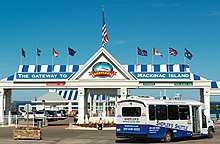
Two ferry companies operate out of Mackinaw City and St. Ignace, connecting tourists and commuters to Mackinac Island: Shepler's Ferry and the Star Line Ferry.
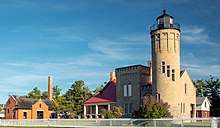
Most of the Straits have been set aside by the state of Michigan as the Straits of Mackinac Shipwreck Preserve, a riparian public space dedicated to those personnel who were lost aboard the boats and ships that sank in these dangerous shipping lanes.
Lighthouses in the Straits of Mackinac include:
- The McGulpin Point Light, on McGulpin Point, three miles (5 km) west of Fort Michilimackinac.
- The Old Mackinac Point Light, in Mackinaw City, which is open to the public.
- The Round Island Light on Round Island, which is not open to the public but which can be viewed from the Mackinac Island ferry channel.
Enbridge pipeline
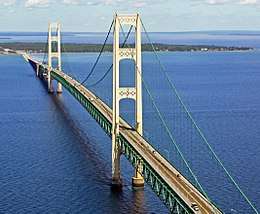
West of the iconic Mackinac Bridge is Enbridge's pipeline, called Enbridge Line 5, which was built in 1953 as an extension of the one-thousand-one-hundred-and-fifty-mile (1,850 km) Interprovincial Pipe Line Company line bringing oil from Alberta to Lake Superior.[7] The 1953 pipeline enters the Straits of Mackinac water on the north shore at St. Ignace, Michigan and lies along the bottom of the Straits which is nearly two hundred and fifty feet (76 m) in places.[3] By 2013 Enbridge had increased the "maximum capacity on the lines to 540,000 barrels per day".[3] In selling the idea of the pipeline to residents living near the Straits, the pipeline developers claimed, it was "essential to the defense of the United States and the whole North American continent".[3] A University of Michigan study studied the risks of a leak, leading to experts and local governments calling for the shutdown of the pipeline.[9][10]
In late June 2019, the state of Michigan filed a lawsuit asking the Ingham County Court to compel the decommissioning of the segment of Line 5 that runs under the Straits of Mackinac.[11] A Reuters news report defined Line 5 as "a critical part of Enbridge’s Mainline network, which delivers the bulk of Canadian crude exports to the United States". The basis of the suit is the claim that the pipeline is a public nuisance and violates the Michigan Environmental Protection Act since it may become the source of pollution. The news report adds that "it is unclear if Line 5 could operate without the Straits segment".[12][13]
Mackinac Straits Corridor Authority
On December 12, 2018, Michigan Governor Rick Snyder signed a bill establishing the Mackinac Straits Corridor Authority, which is charged with overseeing construction and operation of a tunnel to hold a new Enbridge Line 5 under the lake bed in the straits. Snyder also appointed its first members: Geno Alessandrini of Iron Mountain, Anthony England of Ypsilanti and Michael Zimmer of Dimondale, who serve six-year terms.[8]
See also
- Huron Lightship
References
- U.S. Geological Survey Geographic Names Information System: Straits of Mackinac
- Dan Egan (January 18, 2017), Dangerous Straits, A Journal Sentinel Special Report, Milwaukee Journal Sentinel, retrieved February 11, 2017
- Nichols, John D.; Nyholm, Earl (1995). A Concise Dictionary of Minnesota Ojibwe. Minneapolis: University of Minnesota Press.
- Harper, Douglas. "Mackinaw". Online Etymology Dictionary. Retrieved March 8, 2007.
- Ferjutz, Kelly. "Broadcloth, Brocade and Buckskin—Return to the past on Mackinac Island". FrugalFun.com. Retrieved March 8, 2007.
- Flesher, John (March 3, 2014). "Submerged Enbridge Pipeline Under Michigan's Straits of Mackinac Raises Spill Fears". The Huffington Post. Associated Press. Retrieved February 11, 2017.
- "Gov. Snyder signs bill allowing Mackinac Straits oil tunnel". ABC12.com. Gray Television. AP. December 12, 2018. Retrieved December 12, 2018.
- Schwab, David (March 2016). "Statistical Analysis of Straits of Mackinac Line 5 Worst Case Spill Scenarios" (PDF). Graham Sustainability Institute at University of Michigan.
- "Experts Recommend Shutting Down Mackinac Straits Oil Lines". Graham Sustainability Institute News (published 4 December 2015). 6 January 2016.
- "Michigan sues to shut down Enbridge Line 5 pipeline in Great Lakes". Global News. June 27, 2019. Retrieved July 6, 2019.
Michigan’s attorney general sued Thursday to shut down twin 66-year-old oil pipelines in the Great Lakes, saying they pose an "unacceptable risk" and the state cannot wait five to 10 years for Enbridge Inc. to build a tunnel to house replacement pipes running through the Straits of Mackinac.
- "Michigan sues Enbridge to shut down Line 5 oil pipeline through Great Lakes". Financial Post. June 27, 2019. Retrieved June 30, 2019.
The location of the pipelines…combines great ecological sensitivity with exceptional vulnerability to anchor strikes," said Nessel in a statement. "This situation with Line 5 differs from other bodies of water where pipelines exist because the currents in the Straits of Mackinac are complex, variable, and remarkably fast and strong.
- https://www.detroitnews.com/story/news/local/michigan/2019/06/27/nessel-court-line-5-environment-risk-shutdown/1582536001/, Nessel to court: Shut down Line 5 as environmental risk
External links
| Wikimedia Commons has media related to Straits of Mackinac. |

